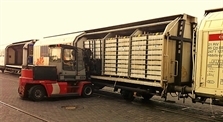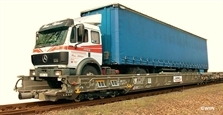Freight services
News Mediarail.be
Freight is often at the origin of transport: this was the case of maritime navigation for long time, then the road transport and recently rail transport. A large number of railway lines were built for coal mines and then connected these mines to the iron and steel factories, and then the major seaports. From the outset, the transport of goods is clearly a transport of volume. This capacity is easily measured in the size of wagons, more superior at that time than any wagon. The transport of freight shows the extent to which railway became a key player in the nineteenth century.
Very quickly, this transport became necessary in all sectors of the industrial economy:
- bulk: minerals, coal, fertilizers, cereals, forest wood, scrap, waste, quarry products, sand, etc.
- heavy products: joists, plates, coils, slabs, tubes, building materials, ...
- chemistry: transport of hazardous liquids, certain gaseous products, petroleum, various fuels ...
- rolling stock: cars, agricultural equipment, rolling stock of all types ...
- intermodal units, which are a recent sector which begins in the 1960s
Rail freight comprises three important subsets:
Very quickly, this transport became necessary in all sectors of the industrial economy:
- bulk: minerals, coal, fertilizers, cereals, forest wood, scrap, waste, quarry products, sand, etc.
- heavy products: joists, plates, coils, slabs, tubes, building materials, ...
- chemistry: transport of hazardous liquids, certain gaseous products, petroleum, various fuels ...
- rolling stock: cars, agricultural equipment, rolling stock of all types ...
- intermodal units, which are a recent sector which begins in the 1960s
Rail freight comprises three important subsets:
The author:
Frédéric de Kemmeter
Railway signalling systems. I'm a rail observer for over 30 years. How has the railway evolved over the decades? Which futur for railways? That's what I'm analyzing and explaining.
Railway signalling systems. I'm a rail observer for over 30 years. How has the railway evolved over the decades? Which futur for railways? That's what I'm analyzing and explaining.

See also:
• My photos on Piwigo gallery
• My YouTube channel
• My blog with latest news
• Follow me on Twitter and LinkedIn
• My photos on Piwigo gallery
• My YouTube channel
• My blog with latest news
• Follow me on Twitter and LinkedIn
Wagon load traffic
Full trains
Intermodal trains



Le trafic diffus représente les wagons isolés qui doivent passer par un centre de triage pour former un train :
- La desserte des usines
- La technique du triage
- Matériel roulant
- Economie du trafic diffus
- La logistique
- La desserte des usines
- La technique du triage
- Matériel roulant
- Economie du trafic diffus
- La logistique
Le train complet est un train effectuant un parcours unique de A vers B, avec en général des wagons identiques :
- La logistique industrielle
- Matériel roulant
- Economie du trafic trains complets
- La logistique
- La logistique industrielle
- Matériel roulant
- Economie du trafic trains complets
- La logistique
Le train intermodal transporte des caisses transbordables du train vers la route, et vive-versa. Il s'agit de caisses mobiles, conteneurs ou camions :
- Les conteneurs
- Les caisses mobiles
- Les semi-remorques
- La route roulante
- Economie du trafic intermodal
- La logistique
- Les conteneurs
- Les caisses mobiles
- Les semi-remorques
- La route roulante
- Economie du trafic intermodal
- La logistique
Details coming later....








-WEc780af7f81.png)


